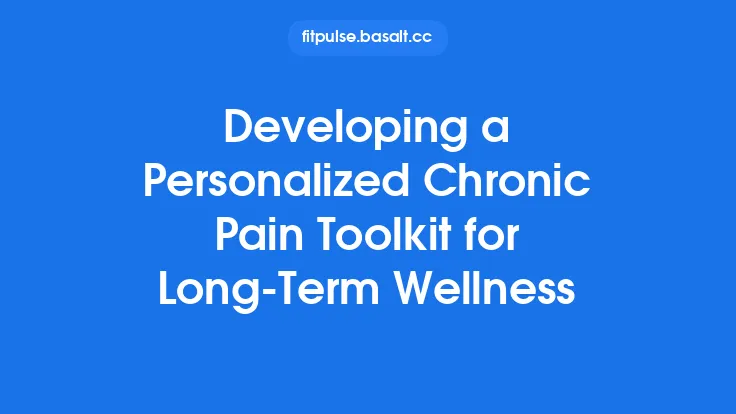Chronic pain is more than an occasional ache; it is a persistent, often debilitating condition that can reshape a person’s daily life, mental health, and overall longevity. While the experience of pain is universal, the mechanisms that sustain it over months or years are complex and multifactorial. Understanding these underlying processes, the various categories of chronic pain, and evidence‑based long‑term strategies is essential for clinicians, patients, and anyone involved in health‑focused longevity planning.
Defining Chronic Pain: Duration and Diagnostic Criteria
The International Association for the Study of Pain (IASP) defines chronic pain as pain that persists or recurs for longer than three months, extending beyond the expected period of tissue healing. This temporal threshold distinguishes chronic pain from acute nociceptive signals, which typically resolve as the underlying injury heals. Chronic pain is not merely “pain that lasts longer”; it often involves maladaptive changes in the nervous system that maintain pain perception even in the absence of ongoing tissue damage.
Key diagnostic elements include:
- Duration: ≥ 3 months, or pain that continues past the normal healing timeline.
- Intensity and Interference: Measured using tools such as the Numeric Rating Scale (NRS) or the Brief Pain Inventory (BPI), which assess both severity and functional impact.
- Underlying Mechanisms: Identification of nociceptive, neuropathic, or nociplastic components guides treatment selection.
Primary Mechanisms Underlying Chronic Pain
Chronic pain arises from a convergence of peripheral and central processes:
- Peripheral Sensitization – Ongoing inflammation or tissue injury lowers the activation threshold of nociceptors, leading to heightened responsiveness to mechanical, thermal, or chemical stimuli.
- Central Sensitization – Repetitive nociceptive input induces long‑term potentiation within dorsal horn neurons, amplifying pain signals and expanding receptive fields. This phenomenon underlies phenomena such as allodynia (pain from non‑painful stimuli) and hyperalgesia (exaggerated pain response).
- Neuroimmune Interactions – Glial activation in the spinal cord and brain releases pro‑inflammatory cytokines (e.g., IL‑1β, TNF‑α) that sustain central sensitization.
- Descending Modulatory Dysregulation – Imbalance between descending inhibitory pathways (e.g., serotonergic, noradrenergic) and facilitatory pathways (e.g., dopaminergic) can perpetuate pain perception.
Classification of Chronic Pain Types
Understanding the dominant pain mechanism informs therapeutic direction. Chronic pain is broadly categorized into three mechanistic groups:
| Category | Pathophysiology | Typical Clinical Examples |
|---|---|---|
| Nociceptive | Persistent activation of peripheral nociceptors due to ongoing tissue injury or inflammation. | Osteoarthritis, chronic low‑back pain from degenerative disc disease. |
| Neuropathic | Damage or dysfunction of the peripheral or central nervous system. | Diabetic peripheral neuropathy, post‑herpetic neuralgia, radiculopathy. |
| Nociplastic | Pain arising from altered nociception without clear evidence of tissue damage or nerve injury; central sensitization predominates. | Fibromyalgia, irritable bowel syndrome–related pain, some chronic headache disorders. |
Peripheral vs. Central Sensitization
- Peripheral Sensitization is often reversible with anti‑inflammatory strategies, local anesthetic blocks, or targeted physical interventions.
- Central Sensitization requires approaches that modulate central excitability, such as certain pharmacologic agents (e.g., gabapentinoids), neuromodulation, or cognitive‑behavioral techniques.
Distinguishing the dominant component can be achieved through clinical clues (e.g., presence of allodynia suggests central involvement) and, when necessary, quantitative sensory testing (QST).
Inflammatory and Autoimmune Contributions
Chronic inflammatory states—rheumatoid arthritis, systemic lupus erythematosus, and inflammatory bowel disease—produce cytokine milieus that sensitize nociceptors and promote central sensitization. Targeted biologic agents (e.g., TNF‑α inhibitors, IL‑6 blockers) have demonstrated not only disease‑modifying effects but also significant reductions in pain scores, underscoring the importance of addressing systemic inflammation in chronic pain management.
Neuropathic Pain: Pathophysiology and Clinical Features
Neuropathic pain stems from lesions or disease affecting the somatosensory system. Key mechanisms include:
- Ectopic Discharge – Damaged axons generate spontaneous action potentials.
- Ion Channel Up‑regulation – Increased expression of voltage‑gated sodium channels (Nav1.7, Nav1.8) heightens excitability.
- Loss of Inhibitory Interneurons – Reduced GABAergic tone in the dorsal horn amplifies pain transmission.
Clinically, neuropathic pain often presents as burning, shooting, or electric‑shock sensations, frequently accompanied by sensory deficits.
Nociplastic Pain: The Emerging Concept
Nociplastic pain reflects a paradigm shift, recognizing that pain can be generated by dysregulated central processing even when peripheral inputs are minimal. Functional neuroimaging studies reveal altered connectivity in pain‑modulatory networks (e.g., default mode network, salience network) in conditions like fibromyalgia. Therapeutic focus shifts toward normalizing central processing rather than targeting peripheral pathology.
Risk Factors and Predisposing Conditions
Multiple variables increase the likelihood of transitioning from acute to chronic pain:
- Genetic Predisposition – Polymorphisms in COMT, OPRM1, and SCN9A influence pain perception and opioid responsiveness.
- Psychosocial Stressors – Catastrophizing, depression, and anxiety amplify pain through shared neurobiological pathways.
- Comorbid Medical Conditions – Diabetes, obesity, and sleep apnea contribute to peripheral nerve dysfunction and systemic inflammation.
- Age‑Related Changes – Degenerative musculoskeletal alterations and reduced endogenous analgesic capacity predispose older adults to chronic pain syndromes.
Impact of Chronic Pain on Physiology and Quality of Life
Chronic pain exerts systemic effects that can accelerate biological aging:
- Neuroendocrine Dysregulation – Persistent activation of the hypothalamic‑pituitary‑adrenal (HPA) axis elevates cortisol, impairing immune function and glucose metabolism.
- Cardiovascular Strain – Sympathetic overactivity raises heart rate and blood pressure, increasing cardiovascular risk.
- Muscle Atrophy – Disuse and inflammatory catabolism lead to sarcopenia, further limiting mobility and metabolic health.
Consequently, chronic pain is a predictor of reduced functional independence, higher healthcare utilization, and increased mortality.
Comorbidities and the Biopsychosocial Model
Effective long‑term management must address the intertwined physical, psychological, and social dimensions of chronic pain. Common comorptions include:
- Depression and Anxiety – Shared neurotransmitter pathways (serotonin, norepinephrine) suggest that treating mood disorders can concurrently alleviate pain.
- Cognitive Impairment – Chronic pain can impair attention and executive function, complicating self‑management.
- Social Isolation – Pain‑related activity limitation often reduces social engagement, feeding a cycle of worsening mood and pain perception.
A biopsychosocial assessment framework (e.g., the West Haven-Yale Multidimensional Pain Inventory) helps clinicians identify and prioritize interventions across these domains.
Pharmacologic Strategies for Long‑Term Management
Medication remains a cornerstone, but selection must balance efficacy, safety, and the risk of tolerance or dependence.
| Drug Class | Mechanism | Typical Indications | Key Considerations |
|---|---|---|---|
| Acetaminophen | Central COX inhibition | Mild nociceptive pain | Hepatotoxicity at high doses |
| NSAIDs | Peripheral COX‑2 inhibition | Inflammatory nociceptive pain | GI, renal, cardiovascular risks |
| Opioids | μ‑receptor agonism | Severe refractory pain | Tolerance, dependence, respiratory depression |
| Antidepressants (TCAs, SNRIs) | Modulate descending inhibition | Neuropathic and nociplastic pain | Anticholinergic effects (TCAs), blood pressure (SNRIs) |
| Anticonvulsants (gabapentin, pregabalin) | Calcium channel α2δ subunit binding | Neuropathic pain | Sedation, edema |
| Topical agents (lidocaine, capsaicin) | Localized sodium channel blockade or TRPV1 desensitization | Focal neuropathic pain | Minimal systemic absorption |
| Emerging biologics (anti‑NGF, CGRP antagonists) | Target specific pain mediators | Osteoarthritis, migraine‑related chronic pain | Ongoing safety monitoring |
Opioid Stewardship – When opioids are necessary, employing the lowest effective dose, regular reassessment, and integrating non‑opioid modalities reduces the risk of misuse. Prescription Drug Monitoring Programs (PDMPs) and urine drug screening are valuable tools for safe long‑term use.
Interventional and Procedural Options
For patients whose pain is refractory to conservative measures, targeted procedures can interrupt pain pathways:
- Peripheral Nerve Blocks – Ultrasound‑guided injections of local anesthetic ± steroids provide diagnostic and therapeutic relief.
- Radiofrequency Ablation (RFA) – Thermal lesioning of nociceptive fibers (e.g., medial branch RFA for facet joint pain) offers months of analgesia.
- Spinal Cord Stimulation (SCS) – Electrical stimulation of dorsal columns modulates pain transmission; newer high‑frequency and burst paradigms improve outcomes for complex regional pain syndrome and failed back surgery syndrome.
- Intrathecal Drug Delivery – Direct administration of opioids or baclofen into the cerebrospinal fluid allows lower systemic doses and improved pain control.
- Joint Injections and Viscosupplementation – Hyaluronic acid or platelet‑rich plasma (PRP) injections can address intra‑articular pathology, though evidence varies.
Procedural selection should be guided by imaging, diagnostic blocks, and a multidisciplinary consensus.
Regenerative and Emerging Biological Therapies
Advances in tissue engineering and molecular medicine are expanding the therapeutic arsenal:
- Stem Cell Therapies – Mesenchymal stem cells (MSCs) derived from bone marrow or adipose tissue exhibit anti‑inflammatory and immunomodulatory properties, showing promise in osteoarthritis and disc degeneration.
- Gene Therapy – Viral vectors delivering genes for anti‑nociceptive peptides (e.g., enkephalins) are under investigation for chronic neuropathic pain.
- Targeted Molecular Inhibitors – Anti‑nerve growth factor (NGF) antibodies (e.g., tanezumab) have demonstrated substantial pain reduction in osteoarthritis but require careful monitoring for joint safety.
While many of these modalities remain investigational, they represent potential paradigm shifts toward disease‑modifying pain treatment.
Lifestyle Interventions Beyond Exercise
Although physical activity is a well‑documented component of pain management, other lifestyle factors exert independent influence on chronic pain trajectories.
Nutrition and Metabolic Considerations
- Anti‑Inflammatory Diets – Diets rich in omega‑3 fatty acids, polyphenols, and antioxidants (e.g., Mediterranean pattern) can lower systemic cytokine levels.
- Weight Management – Excess adiposity increases mechanical load on weight‑bearing joints and secretes adipokines (leptin, resistin) that sensitize nociceptors. Structured weight‑loss programs have demonstrated clinically meaningful reductions in knee osteoarthritis pain.
- Micronutrient Optimization – Deficiencies in vitamin D, B12, and magnesium are linked to heightened pain perception; supplementation should be individualized based on laboratory assessment.
Sleep Optimization for Pain Modulation
Sleep disturbances amplify central sensitization through dysregulated descending inhibition and heightened inflammatory signaling. Evidence‑based sleep hygiene strategies include:
- Maintaining a consistent sleep‑wake schedule.
- Limiting exposure to blue light before bedtime.
- Using cognitive strategies to reduce rumination (distinct from broader mind‑body practices).
- Addressing obstructive sleep apnea with continuous positive airway pressure (CPAP) when indicated, as untreated apnea correlates with increased pain intensity.
Cognitive and Behavioral Approaches
While mind‑body techniques such as meditation are covered elsewhere, cognitive strategies that directly target pain perception are essential:
- Cognitive Behavioral Therapy (CBT) – Structured sessions teach patients to identify maladaptive thoughts (catastrophizing) and replace them with realistic appraisals, reducing pain intensity and improving coping.
- Acceptance and Commitment Therapy (ACT) – Encourages psychological flexibility, allowing patients to engage in valued activities despite pain.
- Pain Education Programs – Providing neurophysiological explanations demystifies pain, decreasing fear‑avoidance behaviors.
These interventions are most effective when delivered by trained psychologists or integrated within multidisciplinary pain clinics.
Patient Education and Self‑Management
Empowering patients with knowledge and practical tools fosters autonomy and long‑term adherence:
- Pain Diaries – Recording pain intensity, triggers, and medication use helps identify patterns and informs treatment adjustments.
- Goal‑Setting Frameworks – SMART (Specific, Measurable, Achievable, Relevant, Time‑bound) goals guide incremental functional improvements.
- Medication Literacy – Understanding dosing schedules, side‑effect profiles, and safe storage reduces misuse and enhances efficacy.
Education should be culturally sensitive and delivered using plain language, supplemented with visual aids when appropriate.
Multidisciplinary Care Models
The most robust evidence for sustained pain reduction and improved quality of life comes from coordinated care teams that integrate:
- Physicians (primary care, pain specialists, rheumatologists)
- Physical and Occupational Therapists – Even when exercise is not the focus, therapists can address ergonomics, posture, and functional adaptations.
- Pharmacists – Optimize medication regimens, monitor for drug interactions, and counsel on adherence.
- Psychologists or Counselors – Provide CBT, ACT, and coping skills training.
- Social Workers – Assist with insurance navigation, community resources, and psychosocial support.
Regular case conferences and shared electronic health records facilitate communication and ensure that treatment plans remain dynamic and patient‑centered.
Monitoring Progress and Adjusting Plans
Long‑term success hinges on systematic evaluation:
- Validated Outcome Measures – Tools such as the Pain Disability Index (PDI) and the Patient‑Reported Outcomes Measurement Information System (PROMIS) capture functional changes over time.
- Periodic Re‑assessment of Mechanistic Dominance – Shifts from peripheral to central sensitization may necessitate changes in pharmacologic or interventional strategies.
- Safety Surveillance – Routine labs for hepatic and renal function, especially when patients are on long‑term NSAIDs or opioids, are essential.
While detailed monitoring tools are discussed in separate articles, clinicians should still incorporate basic, regular assessments into routine visits.
Future Directions in Chronic Pain Research
The field is moving toward precision pain medicine:
- Genomic Profiling – Identifying genetic markers that predict response to specific analgesics (e.g., CYP2D6 polymorphisms influencing opioid metabolism).
- Artificial Intelligence (AI) Analytics – Machine‑learning models that integrate electronic health record data, imaging, and patient‑reported outcomes to forecast pain trajectories and personalize interventions.
- Neuroimaging Biomarkers – Functional MRI signatures of central sensitization may soon guide targeted neuromodulation therapies.
- Microbiome‑Pain Axis – Emerging data suggest gut dysbiosis influences systemic inflammation and pain perception, opening avenues for probiotic or dietary interventions.
Continued investment in translational research will likely yield novel, disease‑modifying treatments that shift chronic pain from a lifelong burden to a manageable condition.
Concluding Perspective
Chronic pain is a multifaceted, dynamic condition that intersects biology, psychology, and social context. By dissecting its underlying mechanisms, recognizing the diverse pain phenotypes, and employing a comprehensive suite of long‑term strategies—including judicious pharmacology, targeted interventional procedures, regenerative innovations, and robust lifestyle and educational components—individuals can achieve meaningful pain control while preserving functional independence and longevity. The ultimate goal is not merely to diminish pain scores but to empower patients to lead active, fulfilling lives despite the presence of chronic pain.





